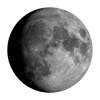Moon Phase on January 3, 1908: New Moon
On Friday, January 3, 1908 the Moon was in its
Image of the Moon Phase on January 3, 1908
The image below represents the phase of the Moon on January 3, 1908.
Credits: this image and other Moon images in this page are derived from public domain material from Lunar QuickMap.
A Note about the Eastern and Western Sides of the Moon
This section sometimes mentions the Eastern or Western side (or limb) of the Moon. It is important to understand that these terms refer to Selenographic Coordinates, which are fixed directions on the lunar surface, analogous to longitude and latitude on Earth. Selenographic 0° longitude is roughly the line that cuts the Moon disc into two equal halves. Selenographic East is defined as the direction of increasing longitude, and Selenographic West is the direction of decreasing longitude, as shown in the following image:
This definition ensures that for an observer on the Moon, the Sun would appear to rise from the selenographic Eastern horizon and set towards the selenographic Western horizon.
From an Earth-based observer's perspective, this convention can be counter-intuitive: the Moon's selenographic Eastern limb is the edge that points towards West and the selenographic Western limb is the edge that points towards East. Another way to think about it is that the selenographic Eastern limb, when observed from Earth, is the limb that rises first, while the Western limb is the limb that sets last.
Additional Resources on TheSkyLive
- The Moon: Complete reference information on TheSkyLive.com.
- Today's Moon Phase: Current phase of the Moon, high-resolution image of its present appearance and list of visible features.
- Next Full Moon: Precise date, time and visibility information of the next Full Moon.
- Next New Moon: Precise date, time and additional information about the next New Moon.
- Moon Calendar: Track the phases of the moon for each day.
- Where is the Moon?: Key information on where to find the Moon in the sky.
- Distance of the Moon from Earth: Find out how far the Moon is from Earth right now.
- How Bright is the Moon?: Current visual brightness (magnitude) and apparent size.
- Rise and Set Times: Rise and set times of the Moon from your location.
- Interactive Sky Map: Planetarium-style interactive visualization of the Moon's position in the sky.
- Ephemeris: 15 days the Moon's computed ephemeris.
- Physical Data: Detailed information about physical properties of the Moon.
The New Moon Phase
The Moon is in its New Moon phase at the very beginning of a lunar phases cycle.
During this phase, the Moon is positioned between the Earth and the Sun.
This alignment means its angular separation from the Sun is close to
From Earth, the side of the Moon facing us is not illuminated by the Sun. Therefore, the New Moon is generally invisible to the naked eye. Occasionally, if the alignment is precise, a New Moon can cause a solar eclipse. The New Moon rises and sets at approximately the same time as the Sun, making it present in the sky during daylight hours but invisiblebecause of the Sun's glare.
Close









